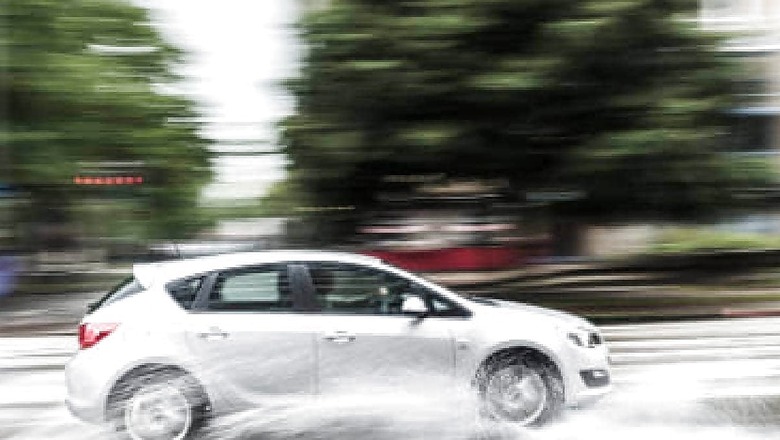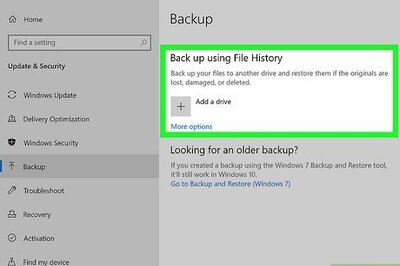
views
As the monsoon season arrives, the pleasant relief of rain can quickly turn into a dangerous hazard on the roads. One of the most significant threats during this period is hydroplaning.
Hydroplaning occurs when a vehicle loses contact with the road surface due to a layer of water, leading to a loss of control and putting drivers at risk of accidents. In this article, we will explore what hydroplaning is, what it feels like, why it happens on wet roads, and crucial safety measures to adopt if you find yourself facing this serious situation.
What is Hydroplaning?
Hydroplaning is the phenomenon where a layer of water builds up between the tyres of a vehicle and the road surface, causing the tyres to lose their grip. When this happens, the driver loses control over the vehicle, and steering and braking become ineffective. The risk of hydroplaning is especially high during the initial moments of rain when the water mixes with the oil and grime on the road, creating a slippery surface.
What Does Hydroplaning Feel Like?
It is essential to recognize hydroplaning in order to avoid danger. When hydroplaning, the vehicle may feel like it’s gliding or floating, and the steering might suddenly become unresponsive. The sensation is often described as feeling disconnected from the road, making it a terrifying experience for drivers. It’s crucial to stay calm and act promptly to regain control and avoid potential accidents.
During Hydroplaning, Should You Accelerate Your Vehicle?
A common misconception when facing hydroplaning is that accelerating will help gain control. However, this is a dangerous myth. Accelerating in this situation will only increase the risk of losing control further. Instead, drivers should do the opposite: release the accelerator gently and avoid sudden movements with the steering wheel. By doing so, the weight of the vehicle can transfer back to the tyres, providing a better chance of regaining traction.
What Should You Do If You Experience Hydroplaning?
If you experience hydroplaning, follow these steps to handle the situation safely:
- Panicking can exaggerate the situation, so take deep breaths and focus on maintaining composure.
- Release the accelerator pedal gently and avoid sudden movements to regain traction.
- Keep a firm grip on the steering wheel and avoid making sharp turns as it can lead to a loss of control.
- Slamming the brakes can cause the vehicle to skid, making it harder to regain control. Instead, apply gentle and steady pressure on the brakes.
As the vehicle slows down, it will eventually regain traction. Once you feel the tyres making contact with the road again, you can slowly accelerate and resume normal driving.
How Do Wet Roads Affect Driving Conditions?
Due to decreased tyre traction, wet roads have a considerable impact on driving conditions. Rainwater creates a thin film on the road, causing tyres to lose grip and increasing the distance required for the vehicle to come to a stop. This decreased traction affects both acceleration and braking thereby making it difficult to control the vehicle.
Why Is It Dangerous to Drive on Wet Roads?
Driving on wet roads is dangerous due to various reasons:
- Hydroplaning: As discussed earlier, hydroplaning is a significant risk on wet roads, making it difficult to control the vehicle and increasing the likelihood of accidents.
- Reduced Visibility: Heavy rain can significantly reduce visibility, making it harder for drivers to see other vehicles, road signs, and obstacles, increasing the chances of collisions.
- Slippery Surfaces: Wet roads become slippery, particularly during the initial stages of rainfall, when oil and grime mix with water, making it harder for tyres to grip the road.
- Increased Braking Distance: Wet roads require a longer braking distance compared to dry roads, increasing the risk of rear-end collisions and the potential for serious accidents.
- Aquaplaning: Aquaplaning occurs when the tyres cannot disperse water quickly enough, resulting in a loss of traction and steering control.
In conclusion, driving during the monsoon season requires one to take precautionary measures. Hydroplaning is a serious threat on wet roads, and recognizing its signs and knowing how to respond can be life-saving. Always remember to drive cautiously, reduce speed, and maintain a safe distance from other vehicles to ensure a safe and enjoyable driving experience during the rainy season.




















Comments
0 comment